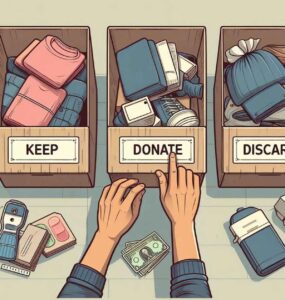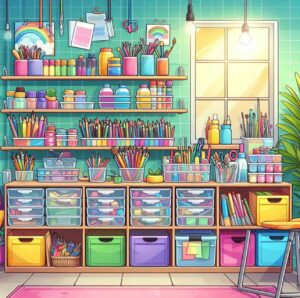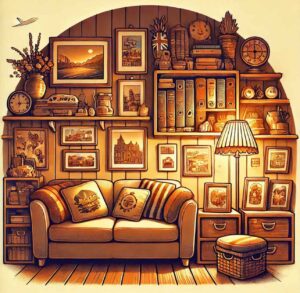Welcome Blessings!
(Tap 🔽 to see more topics!)


Imagine walking into a room and instantly feeling lighter, like a weight has been lifted. That’s the power of a truly organized space where everything clicks. But those picture-perfect, hyper-organized spaces you see online? They aren’t a magic formula. We all dream of a clutter-free, beautifully organized space, but one-size-fits-all organizing solutions don’t exist. Some people thrive with color-coded labels and perfectly arranged shelves, while others need their essentials in plain sight to remember they exist. That’s because organizing isn’t just about cleaning up. It’s about understanding your natural tendencies and working with them, not against them.
Think of it like you wouldn’t try to teach a fish to climb a tree. Trying to force yourself into an organizing system that clashes with your personality is just as pointless. Just like people have different learning styles, we all have unique organizing styles. You’ll fall back into chaos when you try to force yourself into a system that doesn’t match how your brain works. You know that feeling when you spend hours organizing, only for it to look like a tornado hit again a week later? Yeah, that’s what we’re talking about.
Keeping things in order becomes easier once you identify your organizing style. It’s like finding the right pair of shoes; suddenly, everything feels more comfortable and natural. That’s precisely what we are going to discuss in this article: discovering your organizing style and finding the tools to create a space that truly works for you.
Everyone has experienced having a whole Saturday making everything look perfect, those bins labeled, those drawers tidy, and then…poof! A week later, it’s like you never even started. Why does that happen? It’s simple. Your organizing system wasn’t a good fit. It wasn’t designed for you.
Our brain has its way of doing things. Maybe you’re a visual person who needs to see everything, or you thrive on a strict, labeled system. Understanding your organizing style is like getting a user manual for your mind. It means you’ll create systems that stick, not just look good for a day or two. But why it’s so important?
Knowing your organizing style isn’t just about having a neat space. It’s about your well-being, making your life easier and less stressful. It’s about creating a home or workspace that supports you, not fights against you.

1. Traditional Minimalist (The Cricket)
Some folks naturally love a clean, uncluttered space. Think of them as Crickets. They thrive on neatness and everything having its place tucked away. If you feel calmer with less visual clutter, you might be a Cricket.
Being a Cricket can get tricky when you live with someone different, like a ‘Butterfly’ (someone who likes things out in the open). You might be stressed if they leave things everywhere. How do you make it work? A good compromise is to find a middle ground. Maybe you agree on a few open shelves or baskets where they can keep some of their things while the rest of the space stays nice and tidy, as you like. It’s all about finding that balance where everyone feels comfortable.
2. Visual Organizer (The Butterfly)
You know those people who seem to forget something exists the moment it’s tucked away? That’s the Butterfly in a nutshell. It’s that whole ‘out of sight, out of mind’ thing, genuine. If you’re a Butterfly, you’re probably someone who:
Being a Butterfly can sometimes lead to a ‘visual overload.’ All those visible items can feel like clutter if you’re not careful. But, how do you make it work?
It’s about finding that sweet spot where you get the visual reminders you need without feeling like you’re living in a store display. You’re not messy… you need to see your things. That’s okay!

3. The Detailed Organizer (The Bee)
Have you ever met someone who loves labels? Or whose drawers are so perfectly arranged you’d think they were straight out of a magazine? That’s a ‘Bee’ organizer at work. These folks are all about structure and knowing exactly where everything lives. If you’re a Bee, you probably find comfort in:
Bees truly shine when things are organized and predictable. They thrive in environments where there’s a system in place. But sometimes, Bees can get caught up in the details. They might spend hours tweaking and perfecting, which can sometimes slow things down. If you recognize yourself in this, it’s okay! Just remember, sometimes ‘good enough’ is perfect. Don’t let the quest for perfection stop you from getting things done. A simple, workable system can be just as effective as a super-complex one. It’s all about balancing order and living in your space.

4. Quick & Easy Organizer (The Ladybug)
Some of us just aren’t built for super detailed organization. It’s like looking at a pile of stuff, and your brain says, ‘That goes… in that general direction!’ If that sounds familiar, you might be what we’re calling a ‘Ladybug’ organizer. Think of it as needing a more ‘toss and go’ system than ‘fold and label.’ Ladybugs thrive on simplicity. They want things organized but need it to be fast and easy.
Sometimes, the ‘toss and go’ approach can lead to what we call ‘hidden clutter.’ You know, those bins where everything gets thrown in, and you can’t find anything later? But don’t worry! There are ways to make it work.
The main point is, if you’re a Ladybug, embrace it! You don’t have to be a perfect organizer. Just find simple systems that work for your brain, and you’ll be amazed at how much easier life gets.

Organizing isn’t a one-time event. It’s a lifelong journey. Start by setting clear goals for your space. Whether tidying up your closet or transforming your home office, a plan guides your efforts. Next, follow the five fundamental principles of organizing:

Most people are a mix! You might be a Butterfly in your closet, but a Cricket in your office. The key is to adapt your organizing methods to fit different areas of your life.
Pick a system that fits your natural tendencies rather than trying to force yourself into something unrealistic. Also, make organizing easy; you won’t keep up with it if it feels like a chore.
Start small. Choose one space (like a junk drawer or entryway) and organize it using your natural style. Once you see the results, you’ll feel more motivated to tackle more significant projects. Forget those glossy magazine pictures. Real life isn’t about perfect shelves or color-coded closets. It’s about finding peace, relaxing, and feeling good in your space. And guess what? That looks different for everyone.
Whether you’re someone who loves every little detail, like our ‘Bee’ friends, or you’re all about seeing everything at once, like a ‘Butterfly,’ or maybe you want things simple and streamlined like a ‘Cricket,’ or need that quick ‘toss and go’ method like our ‘Ladybug’ pals; there’s no ‘wrong’ way to do this. It’s all about figuring out what clicks for you.
Because trying to force yourself into a system that doesn’t fit is exhausting. It’s like wearing shoes that are too tight. But when do you find the right fit? Suddenly, everything feels more manageable and lighter. Take a moment to think about what works for you. Don’t worry about what anyone else is doing. Embrace your unique style, experiment, and create a space that feels like home.
If you’re curious to learn more and figure out exactly which organizing style you are, or if you’ve got some tips and tricks that work for you, we’d love to hear from you! Please share your thoughts in the comments below, or check out our other articles on productivity to get started on your personalized organizing journey. Voila! Until next time!